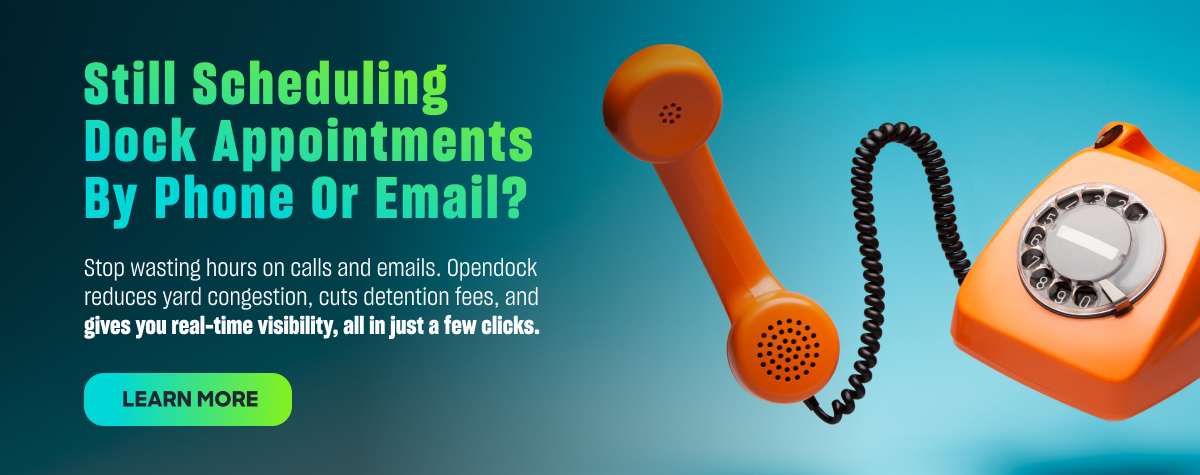Share this
6 Common Mistakes When Using Web Schedules in Logistics
Web-based scheduling tools promise to simplify dock coordination and reduce scheduling headaches — but common mistakes can quickly undermine those benefits.
Improper use can cancel out the advantages of your investment. In this post, we’re going to go over ten common mistakes that could be limiting the potential of your web-based dock scheduling software and how to avoid them.
What Are Web-Based Schedules in Logistics?
Web-based schedules are digital platforms that allow carriers and warehouses to seamlessly coordinate appointments. They eliminate manual coordination via phone calls and emails, saving time and reducing errors.
6 Common Mistakes When Using Web Schedules for Logistics
To reach the utmost efficiency at your warehouse, here are the six common mistakes you should avoid to get the best out of them.
1. Not Keeping Schedule Information Updated
Many facilities set up their web scheduling system once and then forget about it, but failing to keep schedule information updated can create serious disruptions. When working hours, dock capacity, or rules change without being reflected in the system, carriers may book invalid slots, causing overlaps, delays, and frustration.
The system works best when integrated into operations with real-time coordination. Accurate updates on actual dock status and any operational changes ensure the schedule stays current, preventing confusion, wasted labor, and missed appointments. Keeping your scheduling platform up to date is essential for smooth, efficient dock operations.
2. Failing to Customize Settings for Operational Needs
Tailor the system to your workflow. Many facilities simply stick to the default system settings. If it takes 45 minutes to unload at your dock and the default is set to 30 minutes, you should customize it to fit your needs. Take time to set appointment duration, buffer time, and other settings according to your specific operational needs.
3. Overlooking Carrier Self-Scheduling and Training Needs
Carrier self-scheduling is a key part of web-based dock scheduling, but some facilities overlook it, preferring a more ‘hands-on’ approach where bookings go directly through staff. Skipping self-scheduling adds unnecessary manual steps and reduces efficiency.
At the same time, even user-friendly platforms require proper training. Staff and carriers who aren’t trained often only scratch the surface of what the system can do, falling into inefficient habits. By encouraging carriers to use self-scheduling and providing thorough training on all available features, you can maximize the benefits of your dock scheduling tool and keep operations running smoothly.
4. Not Leveraging Reporting and Analytics
Web-based dock scheduling platforms typically have a reporting and analytics dashboard where you can access important data about your operations. You can get information on peak hours, arrivals, departures, and overall carrier performance. Ignoring this data means missing opportunities to fix issues and make informed decisions that improve operations.
5. Allowing Manual Workarounds and Expecting Quick Solutions
Relying on manual workarounds or assuming your digital scheduling system will “fix everything” can quickly undermine efficiency. Allowing manual processes to bypass the platform slips you back into outdated, inconsistent methods, while expecting the system to handle everything automatically leads to missed opportunities for optimization.
Even the best scheduling tools require active management: you need to set rules, train users, update information, and resolve issues within the platform. Treat the system as a powerful tool that supports your operations, not a hands-off solution, to keep scheduling consistent, reliable, and efficient.
6. Too Much or Too Little Access
Web scheduling works best when the right people have the proper level of access. Giving too much access to the wrong people means anyone can modify critical scheduling information. Too little access frustrates legitimate users. The key to avoiding this mistake is to set up role-based permissions that give the right level of access to users and prevent unauthorized changes.
Frequently Asked Questions About Web-Based Dock Schedules
Here are answers to common questions warehouses have before adopting scheduling software.
Will a Web Scheduling System Ensure Accuracy?
When used correctly, a web scheduling system will help ensure accuracy. It replaces error-prone manual processes with standardized booking procedures that minimize human error.
How Do Carriers Schedule Appointments Online?
Carriers schedule appointments online by accessing a dedicated portal or link that a warehouse provides. They can view available time slots and select their preferred appointment time. The major benefit here is that carriers can choose a time slot they’re certain will work best, eliminating cancellations or no-shows later on.
Can Online Scheduling Systems Reduce Wait Times?
Yes, online scheduling systems can reduce wait times. They help prevent scheduling conflicts and give carriers and warehouses clear expectations about appointment timing.
Avoid Errors with Opendock’s Superior Training and Knowledgebase
These common mistakes can erode the gains of web schedules for logistics. When you use Opendock, you get access to the team’s training resources and a dedicated knowledge base that provides guidance to help you avoid these costly mistakes. Book a demo to learn all about it!
Share this
- November 2025 (1)
- October 2025 (16)
- September 2025 (7)
- August 2025 (17)
- July 2025 (3)
- June 2025 (4)
- April 2025 (1)
- March 2025 (1)
- February 2025 (2)
- October 2024 (1)
- August 2024 (1)
- June 2024 (1)
- August 2023 (1)
- May 2023 (2)
- March 2023 (1)
- February 2023 (2)
- January 2023 (6)
- July 2022 (1)
- March 2022 (1)

